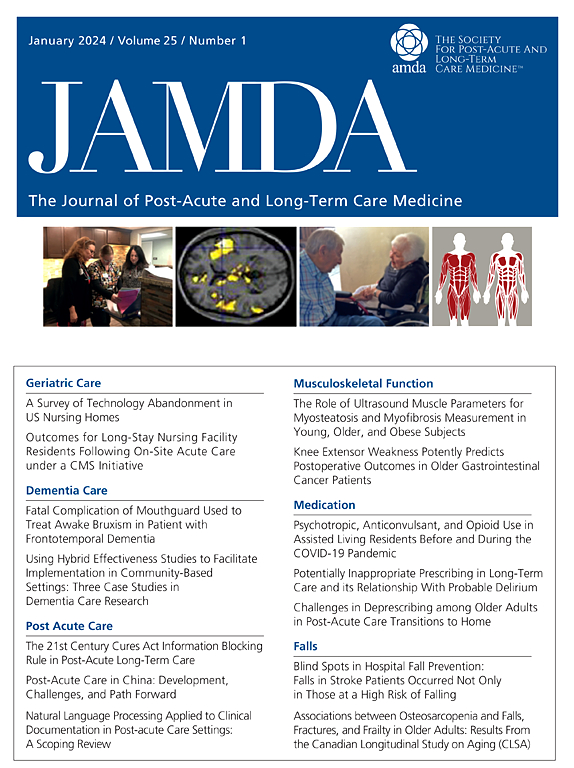Change in Distressed Behavior in Dementia During the COVID-19 Pandemic in Veterans Affairs Community Living Centers
IF 4.2
2区 医学
Q2 GERIATRICS & GERONTOLOGY
Journal of the American Medical Directors Association
Pub Date : 2025-07-19
DOI:10.1016/j.jamda.2025.105752
引用次数: 0
Abstract
Objectives
To compare distressed behavior in Veterans with Alzheimer disease and related dementias (ADRD) residing in Veterans Affairs (VA) Community Living Centers (CLCs) during the COVID-19 pandemic to previous years.
Design
Retrospective cohort study.
Setting and Participants
Veterans with ADRD and without baseline distressed behavior residing in CLCs in March 2020 (Early-COVID) and March 2018 or March 2019 (Pre-COVID).
Methods
We measured distressed behavior with the Distressed Behaviors in Dementia Indicator. Using a Cox regression, we compared the 180-day hazard of distressed behavior in the Early-COVID group to that in the Pre-COVID group.
Results
Of 4383 sampled Veterans, 1190 (27%) had recently taken an antipsychotic medication. In the Pre-COVID (n = 2795) and Early-COVID groups (n = 1588), new distressed behavior occurred in 629 (22.5%) and 313 (19.7%) Veterans, respectively. The adjusted hazard ratio (HR) of new distressed behavior was 0.82 (95% CI 0.71-0.95) for Early-COVID compared with Pre-COVID. Antipsychotic medication was associated with new distressed behavior (HR 1.61, 95% CI 1.40-1.86).
Conclusions and Implications
New distressed behavior decreased during the first 6 months of the COVID-19 pandemic compared with the previous 2 years. The observed association between antipsychotic medication use and distressed behavior may reflect clinical recognition and treatment of a predisposition toward distressed behavior. Recorded changes in distressed behavior in Veterans with dementia residing in CLCs opposed the trend of decreased well-being in residents of non-VA nursing homes, but changes in resident assessment fidelity during the Early-COVID period could have confounded the study.
新冠肺炎大流行期间退伍军人社区生活中心痴呆患者焦虑行为的变化
目的:比较2019冠状病毒病大流行期间与前几年在退伍军人事务(VA)社区生活中心(CLCs)居住的阿尔茨海默病和相关痴呆(ADRD)退伍军人的痛苦行为。设计:回顾性队列研究。背景和参与者:2020年3月(早期covid)和2018年3月或2019年3月(预covid)居住在CLCs的患有ADRD且没有基线痛苦行为的退伍军人。方法:采用痴呆焦虑行为指标对焦虑行为进行测量。使用Cox回归,我们比较了早期covid组与预covid组180天的痛苦行为风险。结果:4383名退伍军人中,有1190人(27%)最近服用过抗精神病药物。新冠前组(n = 2795)和新冠早期组(n = 1588)分别有629人(22.5%)和313人(19.7%)出现新的困扰行为。新出现焦虑行为的调整风险比(HR)为0.82 (95% CI 0.71-0.95)。抗精神病药物与新的痛苦行为相关(HR 1.61, 95% CI 1.40-1.86)。结论和意义:与前两年相比,2019冠状病毒病大流行的前6个月,新的焦虑行为有所减少。观察到的抗精神病药物使用与痛苦行为之间的联系可能反映了临床对痛苦行为倾向的认识和治疗。居住在CLCs的痴呆症退伍军人痛苦行为的记录变化与非va养老院居民幸福感下降的趋势相反,但在早期covid期间居民评估保真度的变化可能会混淆研究。
本文章由计算机程序翻译,如有差异,请以英文原文为准。
求助全文
约1分钟内获得全文
求助全文
来源期刊
CiteScore
11.10
自引率
6.60%
发文量
472
审稿时长
44 days
期刊介绍:
JAMDA, the official journal of AMDA - The Society for Post-Acute and Long-Term Care Medicine, is a leading peer-reviewed publication that offers practical information and research geared towards healthcare professionals in the post-acute and long-term care fields. It is also a valuable resource for policy-makers, organizational leaders, educators, and advocates.
The journal provides essential information for various healthcare professionals such as medical directors, attending physicians, nurses, consultant pharmacists, geriatric psychiatrists, nurse practitioners, physician assistants, physical and occupational therapists, social workers, and others involved in providing, overseeing, and promoting quality

 求助内容:
求助内容: 应助结果提醒方式:
应助结果提醒方式:


